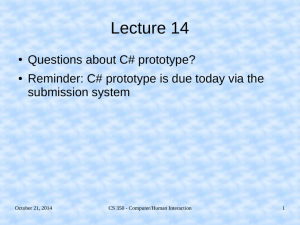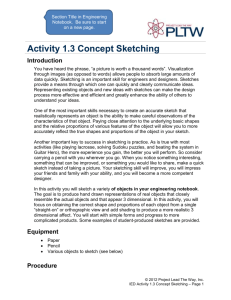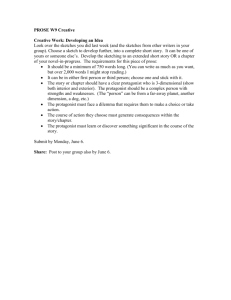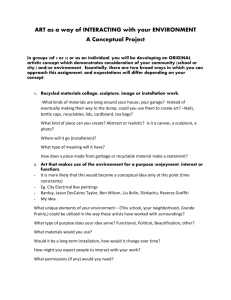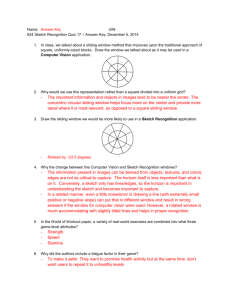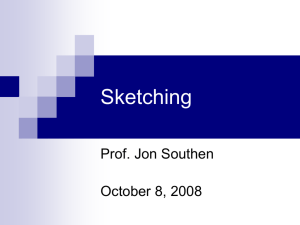course schedule - Stevens Institute of Technology
advertisement
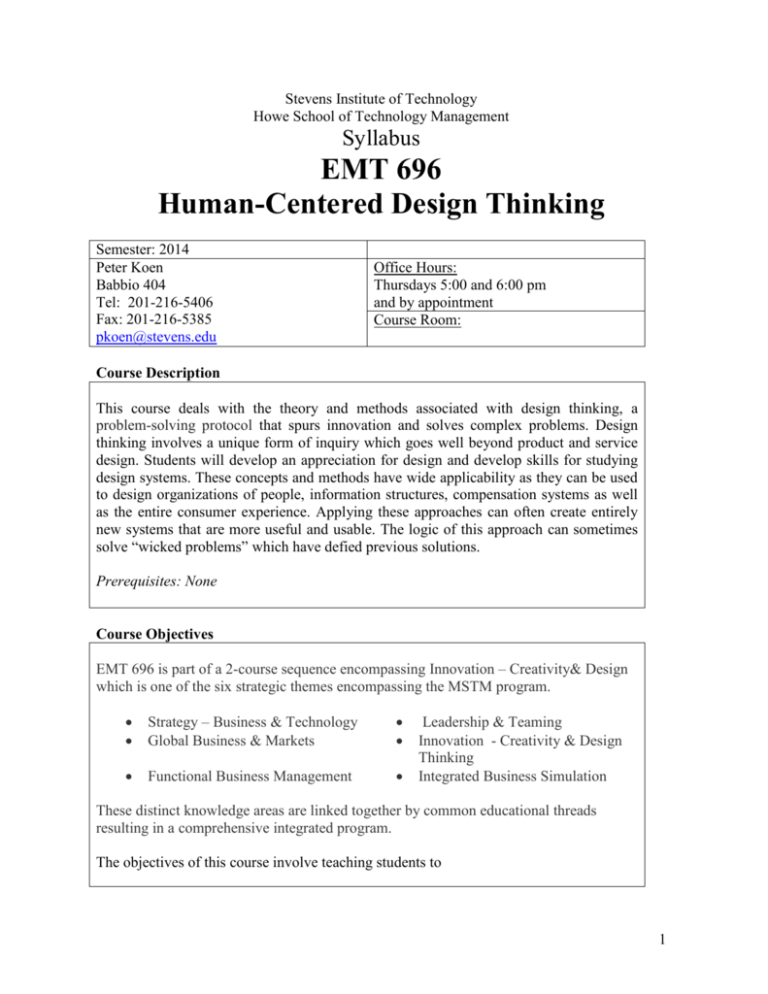
Stevens Institute of Technology Howe School of Technology Management Syllabus EMT 696 Human-Centered Design Thinking Semester: 2014 Peter Koen Babbio 404 Tel: 201-216-5406 Fax: 201-216-5385 pkoen@stevens.edu Office Hours: Thursdays 5:00 and 6:00 pm and by appointment Course Room: Course Description This course deals with the theory and methods associated with design thinking, a problem-solving protocol that spurs innovation and solves complex problems. Design thinking involves a unique form of inquiry which goes well beyond product and service design. Students will develop an appreciation for design and develop skills for studying design systems. These concepts and methods have wide applicability as they can be used to design organizations of people, information structures, compensation systems as well as the entire consumer experience. Applying these approaches can often create entirely new systems that are more useful and usable. The logic of this approach can sometimes solve “wicked problems” which have defied previous solutions. Prerequisites: None Course Objectives EMT 696 is part of a 2-course sequence encompassing Innovation – Creativity& Design which is one of the six strategic themes encompassing the MSTM program. Strategy – Business & Technology Global Business & Markets Functional Business Management Leadership & Teaming Innovation - Creativity & Design Thinking Integrated Business Simulation These distinct knowledge areas are linked together by common educational threads resulting in a comprehensive integrated program. The objectives of this course involve teaching students to 1 1. Become “Design Thinkers” Design thinking is considered the ability to combine empathy within the context of a problem, creativity in the generation of insights and solutions, and rationality to analyze and fit solutions to the context. This course provides methods, tools and processes which will enable the students to evaluate problems from a Human Centered Design perspective, i.e., become design thinkers. 2. Understand how to uncover unarticulated customer needs Being able to empathize is the foundation of the course. It involves defining the problem with the consumer at the center which means observing users in their own habitat, engaging and interacting with them and experiencing what the user experiences. This course will provide methods and tools for doing user research which the student can use to uncover needs that the user may or may not be aware of, supported by a deep understanding of the customer and consumer. 3. Develop competence/ confidence in the design thinking model by using it to solve a real design problem in their company. The students will be guided through each step of the design model through both individual and project assignments in order to develop competence in the key skills. The final project will test the student’s ability to solve a real problem for their company. Additional learning objectives includes the development of: Analytical Problem Solving Skills: Students learn a design-thinking methodology which will enable them to develop and solve transformational and disruptive innovations. Course Outcomes After completing the course, students will be able to 1. Critically discuss potential design methodologies for a given problem setting, 2. Obtain information about users and activities through observation and systematic inquiry, 3. Employ various design methods (i.e. storyboarding, sketching, usability evaluation, scenarios, etc.) to identify a solution. 4. Engage customers and their respective teams in effective collaborative problem solving and communication using methodologies low and high fidelity prototyping. 5. Develop personas that can be used to help articulate the segments interested in both the solution and the problem. 6. Perform a usability evaluation of suggested solutions. 7. Tell the story underlying the methodology and the solution using a video platform. 2 Pedagogy The course integrates lectures, case analysis, team projects and discussions to focus on the implications of social science concepts for marketing strategy. Readings 1. Buxton, B. (2007) Sketching User Experiences: Getting the design right and the right design. San Francisco: Morgan Kaufmann. 2. Moggridge, B. (2010) Designing Interactions. Cambridge, MA: The M.I.T. Press. 3. Cooper, A., Reimann, R., and Cronin, D. (2007) About Face 3. Indianapolis, IN: Wiley Publishing 4. IDEO (2003) IDEO Method Cards: 51 Ways to Inspire Design. William Stout Architectural Books, San Francisco. 5. Spiral bound sketchbook with blank pages. 6. Roam, Dan. The Back of the Napkin: Solving Problems and Ideas with Pictures, Portfolio, 2009. RECOMMENDED. Assignments Class participation :10% Reading reflections :10% Sketching Assignment:10% Individual :15% Final Project :55% Final Project: The final project will consist of a report and video of the design project which the student teams have been working on. This report should include a video story and discuss the feedback which you have obtained from at least 4 users and your stakeholder. The written report should contain: A clear description of the design problem. What problem did you set out to solve? Explain your POV. A clear description of the project scope. What parts of the design did you focus on specifying? What parts of the design are left unspecified? This will help the reader know how well you achieved your goals. Who the target audience. Here you can discuss the personas that you developed. User tests and stakeholder feedback. The user tests you performed and feedback should be included in your report. Impact and Significance. Overall does your solution solve the design problem you envisioned? What works well and equally what issues remain unaddressed. 3 Ethical Conduct The following statement is printed in the Stevens Graduate Catalog and applies to all students taking Stevens courses, on and off campus. “Cheating during in-class tests or take-home examinations or homework is, of course, illegal and immoral. A Graduate Academic Evaluation Board exists to investigate academic improprieties, conduct hearings, and determine any necessary actions. The term ‘academic impropriety’ is meant to include, but is not limited to, cheating on homework, during in-class or take home examinations and plagiarism.“ Consequences of academic impropriety are severe, ranging from receiving an “F” in a course, to a warning from the Dean of the Graduate School, which becomes a part of the permanent student record, to expulsion. Reference: The Graduate Student Handbook, Academic Year 2003-2004 Stevens Institute of Technology, page 10. Consistent with the above statements, all homework exercises, tests and exams that are designated as individual assignments MUST contain the following signed statement before they can be accepted for grading. ____________________________________________________________________ I pledge on my honor that I have not given or received any unauthorized assistance on this assignment/examination. I further pledge that I have not copied any material from a book, article, the Internet or any other source except where I have expressly cited the source. Signature _________________________ Date: _____________ Please note that assignments in this class may be submitted to www.turnitin.com, a web-based anti-plagiarism system, for an evaluation of their originality. Course/Teacher Evaluation Continuous improvement can only occur with feedback based on comprehensive and appropriate surveys. Your feedback is an important contributor to decisions to modify course content/pedagogy which is why we strive for 100% class participation in the survey. All course teacher evaluations are conducted on-line. You will receive an e-mail one week prior to the end of the course informing you that the survey site (https://www.stevens.edu/assess) is open along with instructions for accessing the site. Login using your Campus (email) username and password. This is the same username and password you use for access to Moodle. Simply click on the course that you wish to evaluate and enter the information. All responses are strictly anonymous. We especially encourage you to clarify your position on any of the questions and give explicit feedbacks on your 4 overall evaluations in the section at the end of the formal survey that allows for written comments. We ask that you submit your survey prior to end of the examination period. COURSE SCHEDULE Week Topic(s) Readings Homework Projects Introduction Module 1 Module 2 Module 3 Module 4 Module 5 Module 6 1. Module I: Course overview, review of the syllabus 2. Class activity: Gift giving exercise 3. Begin to develop the design question. Empathy and Insight and Learning How to Sketch 1.Review classmates sketches 2.Presentation: Project I – 3.The Design Question 4.Module II – Empathy Synthesize and Define 1.Review classmates sketches 2. Module III – Synthesize and Define. 3. Understand how to develop a Point of View and Personas. 4. Class Activity: Generate 3 Personas Ideation and Sketching 1. Review classmate’s sketches. 2.Presentation: Project III – POV and personas 3.Module IV - Ideation 4.Class Activity: Each member of the team to develop 6 sketches and chose the 3 most promising to present at the end of the class – Project IV Prototyping Class Activity: Low Fidelity Prototyping 1. Review classmate’s sketches. 2.Module V - Prototyping and Testing 3.Class Activity: Work on Low-Fi Prototype to be presented in class Prototyping and Testing 1.Review classmates sketches 1. Brown, Tim, “Design Thinking,” Harvard Business Review, June 2008. 2. Cooper, A., Reimann, R., and Cronin, D. (2007). Understanding Users: Qualitative Research. Ch. 4 in About Face 3. pp. 49-73. 3. Buxton, W. Sketching User Experiences, pp 40 -104. 1. Moggridge, B. (2010) Designing Interactions and People. pp. 647-681. 2. Cooper, A., Reimann, R., and Cronin, D. (2007) Modeling users: Personas and goals. Ch. 5 in About Face 3. pp. 75108. 3. Cooper, A., Reimann, R., and Cronin, D. (2007) The foundations of design: Scenarios and requirements. Ch. 6 in About Face 3. pp. 109-123. 1. Buxton, W. (2007). The anatomy of sketching. pp. 104-141. 2. Buxton, W. (2007) It was a dark and stormy night, pp. 261-271. 3. Moggridge, B. (2010) Futures and alternative news. pp. 587-611 4. Will need to become familiar with IDEO Method Cards (2003): 51 Ways to Inspire Design. W. Stout Architectural Books, San Francisco in order to do Assignment 2. Sketch 1 Assignment 1: Thinking About Design Project II User Research Report (Homework) Sketch 2 Sketch 3 Assignment 2: Look, Learn, Ask and Try 1. Moggridge, B. (2010) Prototypes. In Ch. 10 of Designing Interactions. Cambridge, MA: The M.I.T. Press, pp. 682-723 Sketch 4 1. Rudd, J., Stern, K. and Isensee, S. (1996) Low vs. high-fidelity prototyping Sketch 5 Assignment Project I – The Design Question (Homework) Project III – POV and personas (Class 3 and Homework) Project IV – Ideation Sketches (Complete in Class 4) Project V Low Fi Prototype (Complete in Class) 3: Project VI – High Fi 5 2.Class Activity: Perform usability test on ModLog from Individual Assignment 3 3. Class Activity: Work on High Fi Prototype. Module 7 Story Telling 1.Review classmates sketches 2.Module VI – Story Telling 3. Class Activity: Storyboard your project in order to create a video for class 8 Module 8 Movie Day and Final Project Presentations debate. Interactions 3 (1), pp. 76-85. \1. Buxton, W. (2007), Storytelling, pp. 277-297. Paper Prototyping Visual 2. Storyboarding: An Empirical Determination of Best Practices and Effective Guidelines. Proceedings of DIS 2006. pp. 12-21. Prototype (Homework) Final Report and Video (Homework) Sketch 6 Sketching Final Report Due 6


